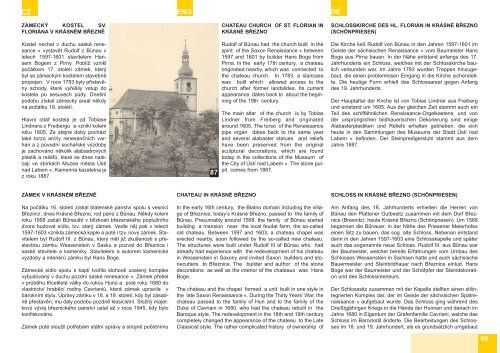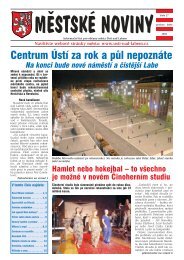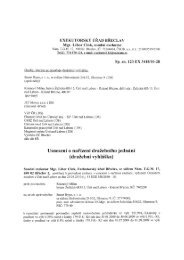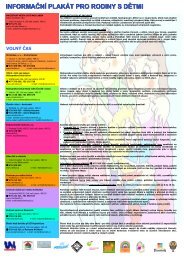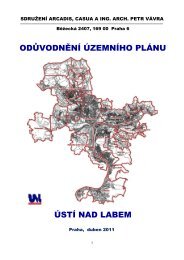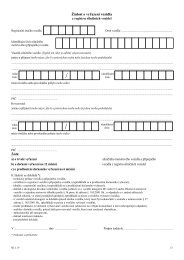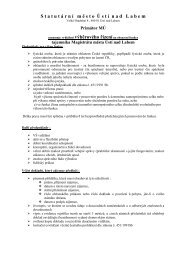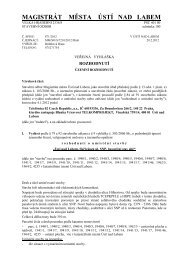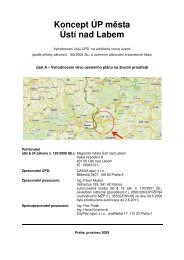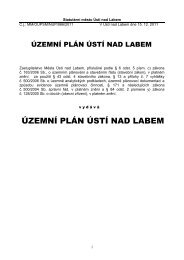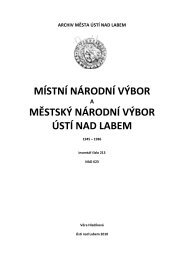Historie a památky města Ústí nad Labem History and monuments of ...
Historie a památky města Ústí nad Labem History and monuments of ...
Historie a památky města Ústí nad Labem History and monuments of ...
Sie wollen auch ein ePaper? Erhöhen Sie die Reichweite Ihrer Titel.
YUMPU macht aus Druck-PDFs automatisch weboptimierte ePaper, die Google liebt.
CZ ENG DE<br />
ZÁMECKÝ KOSTEL SV.<br />
FLORIÁNA V KRÁSNÉM BŘEZNĚ<br />
Kostel nechal v duchu saské renesance<br />
« vystavět Rudolf z Bünau v<br />
letech 1597-1601 stavitelem Hansem<br />
Bogem z Pirny. Poblíž vznikl<br />
počátkem 17. století zámek, který<br />
byl se zámeckým kostelem stavebně<br />
propojen. V roce 1783 byly přistavěny<br />
schody, které vyřešily vstup do<br />
kostela po sesuvech půdy. Dnešní<br />
podobu získal zámecký areál někdy<br />
na počátku 19. století.<br />
Hlavní oltář kostela je od Tobiase<br />
Lindnera z Freibergu a vznikl kolem<br />
roku 1605. Ze stejné doby pochází<br />
také torzo archy renesančních varhan<br />
a z původní sochařské výzdoby<br />
je zachováno několik alabastrových<br />
plastik a reliéfů, které se dnes nalézají<br />
ve sbírkách Muzea <strong>města</strong> <strong>Ústí</strong><br />
<strong>nad</strong> <strong>Labem</strong> «. Kamenná kazatelna je<br />
z roku 1887.<br />
ZÁMEK V KRÁSNÉM BŘEZNĚ<br />
Na počátku 16. století získal blatenské panství spolu s vesnicí<br />
Březnicí, dnes Krásné Březno, rod pánů z Bűnau. Někdy kolem<br />
roku 1568 začali Bűnauští v blízkosti březenského poplužního<br />
dvora budovat sídlo, tzv. starý zámek. Vedle něj pak v letech<br />
1597-1603 vznikla zámecká kaple a poté i tzv. nový zámek. Stavitelem<br />
byl Rudolf III. z Bűnau, který měl již zkušenosti s přestavbou<br />
zámku Wessenstein v Sasku a pozval do Březnice i<br />
saské stavitele a kameníky. Stavitelem a autorem kamenické<br />
výzdoby a interiérů zámku byl Hans Boge.<br />
Zámecké sídlo spolu s kaplí tvořilo slohově ucelený komplex<br />
vybudovaný v duchu pozdní saské renesance «. Zámek přešel<br />
v průběhu třicetileté války do rukou Hunů a poté roku 1680 do<br />
vlastnictví hraběcí rodiny Cavrianiů, která zámek upravila v<br />
barokním stylu. Úpravy zámku v 18. a 19. století, kdy byl zásadně<br />
přestavěn, mu daly podobu pozdně klasicistní. Složitý majetkový<br />
vývoj březnického panství ustal až v roce 1945, kdy bylo<br />
konfiskováno.<br />
Zámek poté sloužil potřebám státní správy a strojně početnímu<br />
87<br />
CHATEAU IN KRÁSNÉ BŘEZNO<br />
CHATEAU CHURCH OF ST. FLORIAN IN<br />
KRÁSNÉ BŘEZNO<br />
Rudolf <strong>of</strong> Bünau had the church built in the<br />
spirit <strong>of</strong> the Saxon Renaissance « between<br />
1597 <strong>and</strong> 1601 by builder Hans Boge from<br />
Pirna. In the early 17th century, a chateau<br />
originated nearby, which was connected to<br />
the chateau church. In 1783, a staircase<br />
was built which allowed access to the<br />
church after former l<strong>and</strong>slides. Its current<br />
appearance dates back to about the beginning<br />
<strong>of</strong> the 19th century.<br />
The main altar <strong>of</strong> the church is by Tobias<br />
Lindner from Freiberg <strong>and</strong> originated<br />
around 1605. The torso <strong>of</strong> the Renaissance<br />
pipe organ dates back to the same year<br />
<strong>and</strong> several alabaster statues <strong>and</strong> reliefs<br />
have been preserved from the original<br />
sculptural decorations, which are found<br />
today in the collections <strong>of</strong> the Museum <strong>of</strong><br />
the City <strong>of</strong> <strong>Ústí</strong> <strong>nad</strong> <strong>Labem</strong> «. The stone pulpit<br />
comes from 1887.<br />
In the early 16th century, the Blatno domain including the village<br />
<strong>of</strong> Březnice, today’s Krásné Březno, passed to the family <strong>of</strong><br />
Bűnau. Presumably around 1568, the family <strong>of</strong> Bűnau started<br />
building a mansion near the local feudal farm, the so-called<br />
old chateau. Between 1597 <strong>and</strong> 1603, a chateau chapel was<br />
erected nearby, soon followed by the so-called new chateau.<br />
The structures were built under Rudolf III <strong>of</strong> Bűnau who had<br />
already had experience with the redevelopment <strong>of</strong> his chateau<br />
in Wessenstein in Saxony <strong>and</strong> invited Saxon builders <strong>and</strong> stonecutters<br />
to Březnice. The builder <strong>and</strong> author <strong>of</strong> the stone<br />
decorations as well as the interior <strong>of</strong> the chateaux was Hans<br />
Boge.<br />
The chateau <strong>and</strong> the chapel formed a unit built in one style in<br />
the late Saxon Renaissance «. During the Thirty Years’ War, the<br />
chateau passed to the family <strong>of</strong> Hun <strong>and</strong> to the family <strong>of</strong> the<br />
Duke <strong>of</strong> Cavriani in 1680, who had the chateau rebuilt in the<br />
Baroque style. The redevelopment in the 18th <strong>and</strong> 19th century<br />
completely changed the appearance <strong>of</strong> the chateau to the Late<br />
Classicist style. The rather complicated history <strong>of</strong> ownership <strong>of</strong><br />
SCHLOSSKIRCHE DES HL. FLORIÁN IN KRÁSNÉ BŘEZNO<br />
(SCHÖNPRIESEN)<br />
Die Kirche ließ Rudolf von Bünau in den Jahren 1597-1601 im<br />
Geiste der sächsischen Renaissance « vom Baumeister Hans<br />
Boge aus Pirna bauen. In der Nähe entst<strong>and</strong> anfangs des 17.<br />
Jahrhunderts ein Schloss, welches mit der Schlosskirche baulich<br />
verbunden war. Im Jahre 1783 wurden Treppen hinzugebaut,<br />
die einen problemlosen Eingang in die Kirche sicherstellte.<br />
Die heutige Form erhielt das Schlossareal gegen Anfang<br />
des 19. Jahrhunderts.<br />
Der Hauptaltar der Kirche ist von Tobias Lindner aus Freiberg<br />
und entst<strong>and</strong> um 1605. Aus der gleichen Zeit stammt auch ein<br />
Teil des schiffähnlichen Renaissance-Orgelkastens, und von<br />
der ursprünglichen bildhauerischen Dekorierung sind einige<br />
Alabasterplastiken und Reliefs erhalten geblieben, die sich<br />
heute in den Sammlungen des Museums der Stadt <strong>Ústí</strong> <strong>nad</strong><br />
<strong>Labem</strong> « befinden. Der Steinpredigerstuhl stammt aus dem<br />
Jahre 1887.<br />
SCHLOSS IN KRÁSNÉ BŘEZNO (SCHÖNPRIESEN)<br />
Am Anfang des 16. Jahrhunderts erhielten die Herren von<br />
Bűnau den Plattener Gutbesitz zusammen mit dem Dorf Březnice<br />
(Bresnitz), heute Krásné Březno (Schönpriesen). Um 1568<br />
begannen die Bűnauer, in der Nähe des Priesener Meierh<strong>of</strong>es<br />
einen Sitz zu bauen, das sog. alte Schloss. Nebenan entst<strong>and</strong><br />
dann in den Jahren 1597-1603 eine Schlosskapelle und später<br />
auch das sogenannte neue Schloss. Rudolf III. aus Bűnau war<br />
der Baumeister, welcher bereits Erfahrungen vom Umbau des<br />
Schlosses Wessenstein in Sachsen hatte und auch sächsische<br />
Bauermeister und Steinbildhauer nach Březnice einlud. Hans<br />
Boge war der Baumeister und der Schöfpfer der Steindekoration<br />
und des Schlossinterieurs.<br />
Der Schlosssitz zusammen mit der Kapelle stellten einen stilintegrierten<br />
Komplex dar, der im Geiste der sächsischen Spätrenaissance<br />
« aufgebaut wurde. Das Schloss ging während des<br />
Dreißigjährigen Kriegs in die Hände der Hunnen und danach im<br />
Jahre 1680 in Eigentum der Grafenfamilie Cavriani, welche das<br />
Schloss im Barockstil änderte. Die Bearbeitungen des Schlosses<br />
im 18. und 19. Jahrhundert, als es grundsätzlich umgebaut<br />
99


